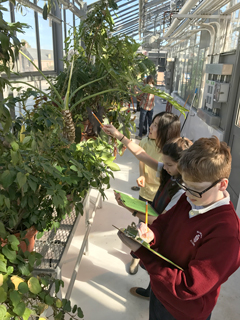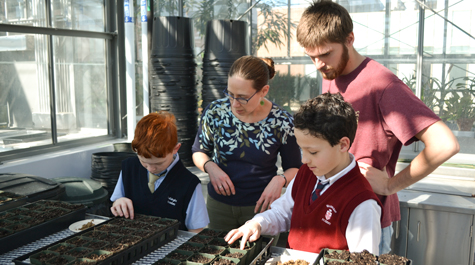Cool plants & citizen science: Walsingham students visit the greenhouse
Students from the Walsingham Academy recently visited the new greenhouse atop William & Mary’s Integrated Science Center and taking on the role of citizen-scientists.
The Walsingham 5th graders are members of Kim Ward’s class. They toured the greenhouse and roamed through the facility on a scavenger hunt, searching to match the proper specimens of rare or exotic plant with clues on a worksheet with some assistance from a group of volunteers recruited from William & Mary’s biology majors.
But their most important activity was planting milkweed seeds.
William & Mary plant biologists Harmony Dalgleish and Joshua Puzey have enlisted the Walsingham students in their army of citizen scientists assisting in the study of milkweed, a valuable — even essential — plant for the life cycle of the monarch butterfly.
Monarchs are in trouble, largely due to deforestation of their Mexican wintering grounds. Dalgleish and Puzey, both assistant professors in the university’s Department of Biology, have been working on an investigation of milkweed, a species that’s also in decline, a double whammy for the charismatic monarch.
Known as Danaus plexippus to Linnaeus, there is a school of thought that the butterfly’s common name was inspired by the association of the wing color with William of Orange, the very William III of William & Mary. In some places, the butterfly was actually known familiarly as the King Billy in years past.
 Puzey and Dalgleish are not only studying milkweed, but also serving as a kind of “Johnny Milkweedseed, ” encouraging propagation of a plant that has largely been regarded as an undesirable weed. Ward says she and her students are happy to join the effort.
Puzey and Dalgleish are not only studying milkweed, but also serving as a kind of “Johnny Milkweedseed, ” encouraging propagation of a plant that has largely been regarded as an undesirable weed. Ward says she and her students are happy to join the effort.
“My main goal is for the students to see the process from seed, to plant, to the critter that’s going to be living in the habitat that we create,” Ward said.
Ward’s students took flats they seeded back to Walsingham. They will tend the seedlings, nursing them to become the centerpiece of a habitat producing as many of the orange-winged critters as they can.
“We hope to get it Monarch Waystation certified, to get on the map as one of the official schools in the commonwealth,” Ward said. The certification is offered through Monarch Watch, a nonprofit dedicated to restoring the monarch butterfly. “Many criteria have to be met before that happens, and this is step one.”
Dalgleish explained that most insects can’t eat milkweed, as it contains a stew of noxious and toxic chemicals, but those cardenolides don’t faze the monarch butterfly. In fact, monarch lava eat only milkweed, and the toxicity of a milkweed diet is the half the point.
“Monarchs tolerate the chemicals, and they actually sequester them and use them for their own defense,” she continued. “So they keep the toxic chemicals inside and predators don’t want to eat them.”
Ward’s students are learning about the monarch-milkweed connection. The butterflies lay eggs on milkweed, they hatch on milkweed and spend the next two stages of their lives — larva and pupa — on milkweed. It’s only when a monarch emerges from its pupa, becoming an actual butterfly, that it leaves its stalk of Asclepias syriaca or a related species and flies away from the milkweed-only diet.
The students planted milkweed seeds from a number of sources across the country. Their monarch garden will help in a comparative study of different strains of the plant.
“Using the milkweed plants from different geographic location, they will compare patterns of growth and flowering time in a common garden experiment at Walsingham,” explained Puzey.
“It ties into the work that Josh and I have been doing,” Dalgleish added, gesturing toward tables filled with pots bearing geographic labels, each of which contains germinating milkweed seed.
“We have these collections from all over the U.S. We’re investigating differences in chemistry — the toxic chemicals they produce,” Dalgleish continued. “The Walsingham students are going to plant them in a common garden at their school and take some of the same data at their school garden that we’re doing here in the greenhouse.
The folks at the greenhouse are planning another outreach activity. Partnering with William & Mary’s Office of Sustainability, they will host W&M Earth Day: Monarchs and Music. It’s scheduled for April 22, Earth Day.
The festival will be free and open to the public with live music sponsored by AMP. There will be family-friendly activities, capped by a butterfly tent.
“People can have live monarchs land on them!” Puzey said.














